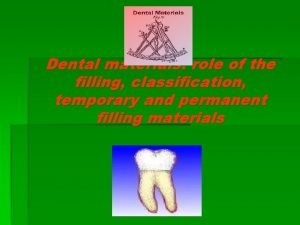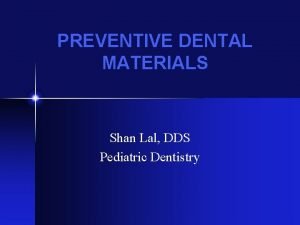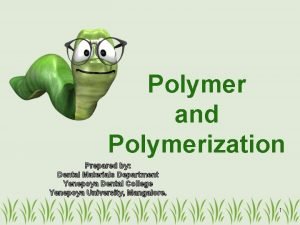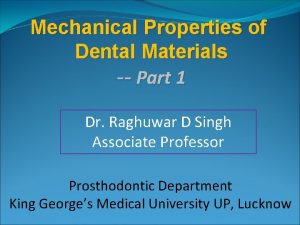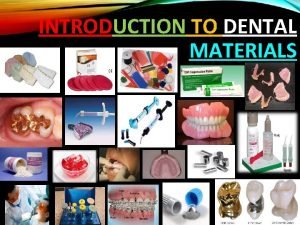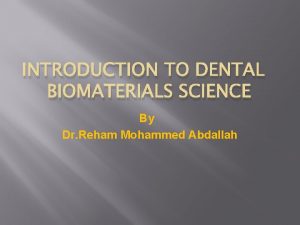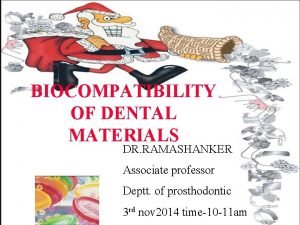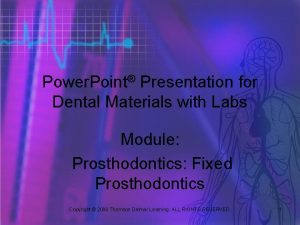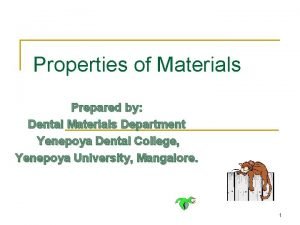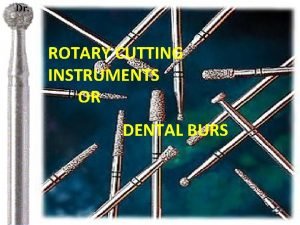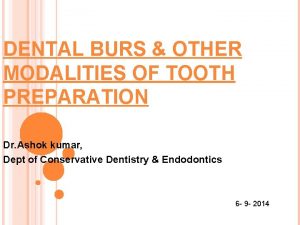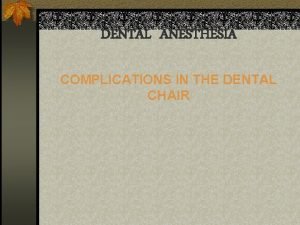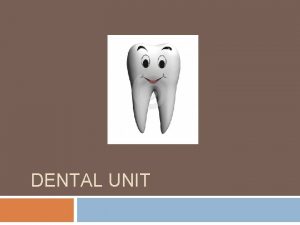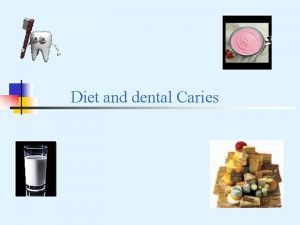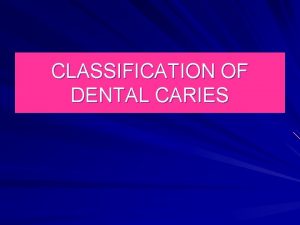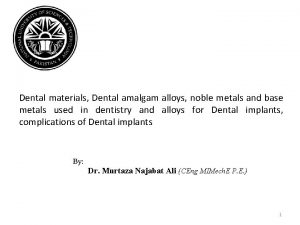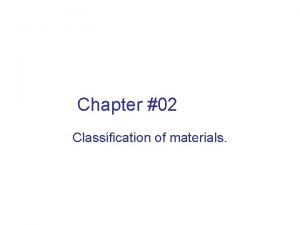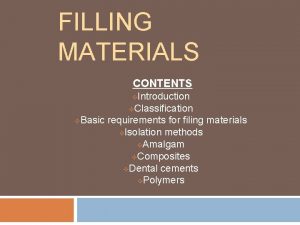Dental materials role of the filling classification temporary



























- Slides: 27

Dental materials: role of the filling, classification, temporary and permanent filling materials

§ Conservative treatment of caries, when the pulp is vital and unexposed, is by filling. § If the pulp si exposed or dead, root canal therapy is usually necessary before the filling is done.

Dental materials § What is a Filling? § A filling is a way to restore a tooth damaged by decay back to its normal function and shape. § Dental fillings are dental materials that have been used to repair a decayed tooth. § The tooth is first prepared using dental drills to remove decay and create space for the dental material of choice – then the material is inserted.

§ The normal function of the tooth is thereby restored, pain is prevented, and the vitality of the pulp is preserved. § In front teeth, fillings restore normal appearance, in back teeth, stagnation areas can be eradicated and further caries prevented.

Which Type of Filling is Best? § No one type of filling is best for everyone. § Each has its advantages and disadvantages, and where and when it can be used. § The location and size of the decay often limits your options.

Dental materials are grouped into two main categories: § A) Temporary Fillings: These are inserted as a temporary measure only. They are too soft to use as permanent fillings. The temporary fillings are: - Zinc oxide and eugenol cement - Zinc phosphate cement - Zinc polyacrylate cement - Gutta-percha


Generations of Cements Zinc Phosphate Polycarboxylate Glass Ionomer Resin-Modified Glass Ionomer Composite Cement What do you use ? ? ?

Temporary Fillings § They are not used as permanent fillings as they are too soft and soluble and would not remain intact for long periods. § Calcium hydroxide cannot be used as a temporary, it is an excellent cavity lining.

Uses of Temporary Fillings 1. As a first-aid measure to relieve pain, 2. When there is insufficient time to complete the cavity and insert a permanent filling in one visit, 3. For permanent fillings requiring more than one visit, e. g. inlays, crowns, a temporary restoration is necessary between visit.

Purpose of Cavity Linings 1. Protection of pulp against thermal shock, i. e. conduction of heat or cold through metal fillings 2. Protection of pulp against chemical irritation of non-metallic fillings

§ ZOE- zinc oxide eugenol § Temporary medicated fillings (zinc oxide eugenol or ZOE) can be used when a tooth is too sensitive with a regular filling and the dentist wants to see if it will calm down before putting a permanent filling back in, or he may think you need one to begin with for a while before he puts in a permanent

§ Temporary fillings are made of two major components: § Oil of clove (eugenol), which has been used for centuries to relieve toothaches, and Zinc Oxide powder. § Zinc oxide is an excellent disinfectant. The oil and oxide mix together to make a stiff paste that eventually hardens into a waterproof substance which soothes the nerve of the tooth and kills germs while protecting the cavity like a hard band aid. When used as a temporary filling material or cement, this material is called “zinc oxide and eugenol”, ZOE for short

ZOE - Advantages § It is also used as a temporary filling and as a non irritant lining for very deep cavities. It is also used as a permanent root filling. In addition it is often used as a sedative dressing for dry sockets and gingivectomy. § Disadvantages: § It is too soft to use it for a permanent filling § It is not compatible with every kind of non metallic filling

Zinc phosphate cement § Contains zinc oxide powder and phosphoric acid liquid, which must be mixed together to the creamy consistency. § Use as a cavity lining for amalgam fillings and permanent root filling and in prosthetics as a adhesive cement for cavities and crowns. § Advantages- it is drying quickly and is enough adhesive to be layed under inlays and crowns. § Disadvantages- it is irritant in the deep cavities, that´s why has to be sub- lined by the calcium hydroxyde. § Bad adhesivity to a wet cavity.

Zinc polyacrylate cement § Contains zinc oxide powder and polyacrylic acid liquid. § Use as an alternative of zinc phosphate cement. § Adv. : it is less irritant and more adhesive than the zinc phosphate cement. Because of it´s adhesivity it is more difficult to prepare it.

GUTTA-PERCHA § Contains eucalyptus and petroleum oil. It is supplied in white or pink sticks. § Use: as a temporary filling for inlay cavities § - vitality tests § - permanent filling for root canals § - temporary obturator for cleft palates and cyst cavities § - lining for Gunning splints § Adv. : it needn´t to be mixed and hardens immediatelly § Disadv. : it is too soft and decomposes if left in a cavity too long. §

Calcium Hydroxide § Contains Calcium hydroxide powder and water as liquid § Use: as a cavity lining. It promotes formation of secondary dentine and repair of hard tissue, and is also used for pulp capping, pulpotomy and other root treatment procedures. § Adv: non irritant, can be used in deepest cavities and it is compatible with all materials § Disadv: sub. lining only, in deep cavities under metal fillings

§ B) Permanent Fillings: § Permanent fillings fall into two categories based on the method used to place them: They are: § A) direct restorations § B) indirect restorations A) Direct restorations are fillings placed immediately into a prepared cavity in a single visit.

§ They include dental amalgam, glass ionomers, resin ionomers and most composite (resin) fillings. The dentist prepares the tooth, places the filling and adjusts it during one appointment. ( next lectures)

§ B) Indirect restorations may require two § § or more visits. They include inlays, onlays, veneers, crowns and bridges fabricated with gold, ceramics or composites. During the first visit, the dentist prepares the tooth and makes an impression of the area to be treated. The impression is sent to a dental laboratory, which creates the dental restoration (filling). At the next appointment, the dentist cements the restoration to the prepared tooth and adjusts it as needed.

§ Dental amalgam § The word “amalgam” when referring to dental fillings means a mixture of two or more metals in which mercury is a component. § Dental amalgam is a mix of approximately 43 percent to 54 percent mercury with other metals, including silver, copper and tin. Today, amalgam is used most commonly in the back teeth. It is one of the oldest filling materials and has been used (and improved) for more than 150 years.

Amalgam

Composite (resin) § Composite is a mixture of acrylic resin and powdered glass-like particles that produce a tooth-colored filling. This type of material may be self-hardening or may be hardened by exposure to blue light. Composite is used for fillings, inlays and veneers. Sometimes it is used to replace a portion of a broken or chipped tooth.

Composite

Glass Ionomer § Glass ionomers are tooth-colored materials made of a mixture of acrylic acids with fine glass powders that are used to fill cavities, particularly those on the root surfaces of teeth. They are primarily used for small fillings in areas that need not withstand heavy chewing pressure. Glass ionomers also are used to cement dental crowns.

Thank you for your attention
 Classification of filling materials
Classification of filling materials Silver cone obturation disadvantages
Silver cone obturation disadvantages Preventive dental materials
Preventive dental materials Polymerization in dentistry
Polymerization in dentistry Physical properties of dental materials pdf
Physical properties of dental materials pdf Elastic range
Elastic range Auxillary dental materials
Auxillary dental materials Auxiliary dental material
Auxiliary dental material Biocompatibility of dental materials
Biocompatibility of dental materials Impression materials in dentistry ppt
Impression materials in dentistry ppt Auxiliary dental materials
Auxiliary dental materials Introduction to dental materials
Introduction to dental materials Dental materials
Dental materials Azure web role worker role example
Azure web role worker role example Krappmann schaubild
Krappmann schaubild Statuses and their related roles determine
Statuses and their related roles determine Go noodle cant stop the feeling
Go noodle cant stop the feeling Household material useful
Household material useful Man made materials
Man made materials Adapting and adopting materials
Adapting and adopting materials Direct materials budget with multiple materials
Direct materials budget with multiple materials Glickman's concept of trauma from occlusion
Glickman's concept of trauma from occlusion Types of dental burs
Types of dental burs Corrective wax
Corrective wax Contraindications of composite restoration
Contraindications of composite restoration Gingival margin trimmer dental instrument
Gingival margin trimmer dental instrument Burs for cavity preparation
Burs for cavity preparation Dental licentiate
Dental licentiate
